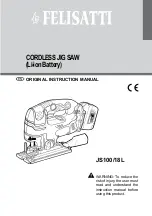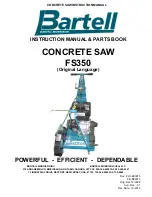
GB
- 81 -
•
Set the parallel stop (7) in accordance with the workpiece height
and the desired width. (See 7.3.)
•
Switch on the saw.
•
Place your hands (with fingers closed) flat on the workpiece and
push the workpiece along the parallel stop (7) and into the blade
(4).
•
Guide at the side with your left or right hand (depending on the
position of the parallel stop) only as far as the front edge of the
guard hood.
•
Always push the workpiece through to the end of the splitter (5).
•
The offcut piece remains on the saw table (1) until the blade (4)
is back in its position of rest.
•
Secure long workpieces against falling off at the end of the cut
(e.g. with a roller stand etc.).
8.1.1 Cutting narrow workpieces (Fig. 22)
Be sure to use a push stick (3) when making longitudinal cuts in
workpieces smaller than 150 mm in width. A push block is supplied
with the saw! Replace a worn or damaged push stick immediately.
8.1.2 Cutting extremely narrow workpieces (Fig. 23)
•
Be sure to use a push block when making longitudinal cuts in
very narrow workpieces with a width of 50 mm and less.
•
The low guide face of the parallel stop is best used in this case.
•
There is no push block supplied with the saw! (Available from
your specialist dealer). Replace the push block without delay
when it becomes worn.
8.2 Making bevel cuts (Fig. 24)
Bevel cuts must always be used using the parallel stop (7).
If you tilt the saw blade (4) to the left when making angular cuts,
position the parallel stop (7) on the right-hand side of the saw blade
(4). Guide the workpiece between the saw blade (4) and the parallel
stop (7).
•
Set the blade (4) to the desired angle. (See 7.5.)
Anl_TC_TS_2000_U_SPK9.indb 81
Anl_TC_TS_2000_U_SPK9.indb 81
28.04.2020 14:40:10
28.04.2020 14:40:10












































